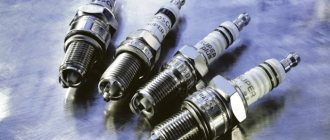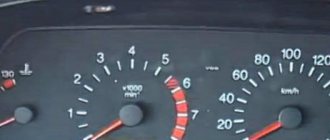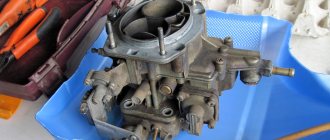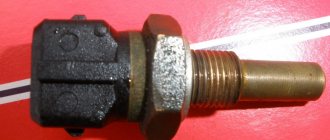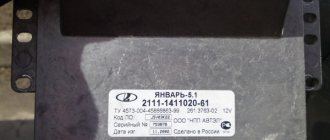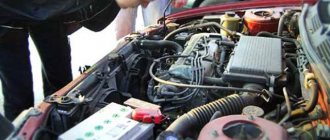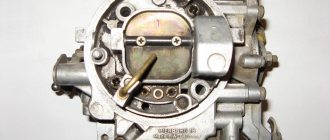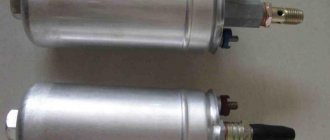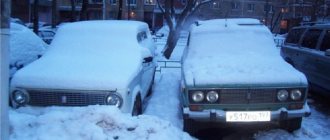If your VAZ-2107 car has a malfunction, as a result of which the engine stalls, further movement becomes problematic. But finding the cause of this malfunction for the G7 injection engine is quite difficult without the presence of diagnostic equipment, since, unfortunately, there are many reasons why the crankshaft stops rotating.
Most often, an injection engine gets stuck in idle mode.
... The throttle body with idle air control (IAC) assembly could be involved in this problem because while the engine is running, the throttle body can become very dirty, causing the IAC rod to become stuck. To ensure this, it must be removed and, if contaminated, carefully washed with liquid detergent oil mixed with dirt.
If your car has a VAZ-2107 alarm system
, which works with the electrical circuit of the fuel pump, the reason for the engine stopping may be poor quality work of the person who installed it. If this is done during twisting, then the poorly compressed twist weakens over time and, as a result, contact is lost. As a result, the electric fuel pump stops working.
A possible reason for the engine stopping could be an enriched fuel mixture.
... You can check this by removing the spark plugs. If they are covered with black charcoal, the mixture is rich. The amount of gasoline supplied to the engine cylinders depends on the position of the throttle valve and the correct reading of the temperature sensor, which is wound on the left rear of the cylinder head. When replacing it, it will be necessary to partially drain the antifreeze from the cooling system.
Failure of the mass air flow sensor also leads to a strong enrichment of the mixture
(DFID). You can check the condition with a multimeter. The measurement is made between the green and red wires (2nd and 4th terminals, counting from left to right) with the ignition on. If the voltage is higher than 1.002 volts, it needs to be replaced.
If the fuel mixture becomes too lean, the engine will also stall. And its depletion occurs due to air leakage behind the throttle assembly. Possible places for air leaks are usually the intake system gaskets, either due to the loosening of the fasteners of the parts between which they are located, or due to their breakage. Air leaks can be detected using a smoker used by beekeepers. Having smoked the engine compartment with it, you will immediately see where the smoke is drawn into. And at decent gas stations, instead of a smoker, they use a device called a smoke generator.
In this article we will talk about such an unpleasant problem as engine stalling and poor starting. Let's look at the main reasons why the engine stops at idle and while driving. We will also talk about why the engine does not start hot, as well as options for solving each of the above problems.
Finding the faulty component
So, what should you do if the engine starts easily, but immediately slows down and stops? First of all, check for carbon deposits on the spark plugs. If some of them are covered with a layer of carbon, the engine a priori cannot operate normally. It starts initially due to the movement of the starter, but soon thereafter slows down as several cylinders are physically unable to support the full load from the crankshaft. The carburetor, by the way, can also fail due to such a problem.
So what is the cause of engine failure? If the car starts, then at least the spark is fine. That is, the electrics work as expected. It wouldn’t hurt to turn your heads and try to find those candles covered with a layer of soot. They can be cleaned by burning them on a gas stove and wiping them with alcohol (this can only be done on cold contacts).
The injector itself may also become clogged. In this case, the fuel supply to the combustion chamber simply does not work. You need to do the following:
- Check if the motor operates normally at temperatures above 80°C.
- remove the blocks and check the shock absorbers;
- check the operation of the sensors;
Of course, the fuel pump itself may fail. When the engine starts, it automatically turns into an injector due to the starter, so there is draft from the generator. If any of these components fail, the car will simply collapse. Again, this is the remaining amount of fuel in the cylinders. If the engine stops immediately, and along with it the starter works unevenly, then most likely the problem is in it or in the ignition switch.
You should try replacing it with a known one and check the engine operation again. In extreme cases, the contacts are simply tightened.
When the candles are lit
If the VAZ-2107 injector starts poorly (it catches, but does not start), it means that the combustion chamber is overfilled with gasoline. The normal fuel to air ratio should be 1:14. This problem often happens on such cars. When starting, the fuel pump pumps a lot of gasoline. By the way, on injection engines it is electric, submersible type. Installs directly into the tank.
How to dry candles without removing them? To do this, open the throttle valve when starting. It is mechanical here and is activated by pressing the accelerator trigger through a cable drive. This will allow more air to enter the combustion chamber and the engine will start immediately.
The engine stops while running - reasons
1. Poor quality fuel is the first thing that comes to mind for most of us, and this is where we need to start looking for the reason for the engine stopping. You will be lucky if this happens immediately after refueling, in which case it is safe to say that the problem is in the fuel. Treated by draining the fuel and.
2. Candles. As a rule, suspicion falls on them most often, of course, after bad fuel. Everything is simple here - unscrew the spark plugs and, if necessary, check their condition.
3. Fuel filter. A clogged filter can cut off the fuel supply, causing gas and stalling the engine. It is enough to eliminate the malfunction.
4. Air filter. Everything is the same as with fuel, if it is clogged, air does not flow, then again the air-fuel mixture comes out enriched and the spark plugs are simply flooded. In addition, due to a lack of air, the engine will throttle, that is, the power will decrease and the process of combustion of the mixture in the cylinders will not be able to occur, and over time the engine will stall. To eliminate this problem, it is enough to replace the air filter.
5. A faulty fuel pump is the second “suspect”. If your fuel pump fails, your car will behave like this: it will stall while driving or the engine will not start at all. The problem can be solved by checking the pump, repairing it or.
6. Battery. Oxidated battery terminals or poor connections can cause the engine to stall. Check the terminals and clean or replace the battery if necessary.
7. If the engine stops moving and will no longer start, the alternator may also be the cause. A failed generator does not charge; as a result, the vehicle’s on-board network is powered exclusively by the battery and, as we know, will not last long. As a result, you, unaware that the car is running on battery power, continue to drive until it is completely discharged. Treated - a.
6. In advanced cars, the reasons may also be in electronics and various sensors. If you are not good at this and all of the above components and parts are normal, then it is better to contact specialists, otherwise you can replace the nonsense car floor using the “dialing…
MAIN ROAD | Thread Posted by: Kyung
WHY DOES THE ENGINE STALL AFTER STARTING?
Most often, the reason that the engine stalls after starting is a breakdown of the idle air control. Domestic cars are more susceptible to this “disease”. In second place is an injector malfunction associated with a modern fuel injection system, which is carried out forcibly. It is possible that problems may be found in the operation of the fuel pump and in the ignition. The engine crankshaft timing sensor may have failed. These are the most common causes of a stalled engine.
Much less often, when the engine stalls after starting, the electronic control unit (ECU) and failed injectors are to blame. In the latter case, this circumstance can affect the operation of the engine only if the operation of several at once is disrupted - and this is an exceptional phenomenon.
We carry out diagnostics of IAC
Now that the range of possible problems that can cause the engine to stall is approximately outlined, we will tell you how you can effectively diagnose this or that breakdown. Let's start with a malfunction of the idle air control. In the event that he is the culprit, the engine may behave like this:
1. Fail to start or stall immediately after a short stop during a long trip. At the same time, the engine is hot; 2. You finally managed to start the engine, which stalls after starting, but the normal idle speed was not set immediately, but only after pressing the gas. This situation can occur with either a hot or cold engine; 3. The engine can only be started with the gas depressed, otherwise the engine will immediately stall; 4. In order to start the engine, you have to hold the accelerator pedal constantly while the engine warms up, or until the car starts moving; 5. Freezing of idle speed within 1500-2000 revolutions also speaks in favor of a malfunction of the idle speed controller.
If after the diagnostics you are sure that the problem is in the IAC, then you should wash it and the throttle assembly, and in extreme cases, simply replace the idle air control with a new one.
If the most common reason that the car stalls immediately after starting the engine is not confirmed in your case, we will look for the breakdown further. A little experience and the ability to listen to your car will help you determine the performance of the fuel pump by sound. As an alternative method, you need to check the wiring by applying 12 V to the fuel pump, while you need to monitor the pressure in the fuel system, it should be within 2-3 bar. The pressure should not drop immediately after the fuel supply to the engine is stopped. If this does happen, check the fuel pressure regulator.
After this, in order to determine why the engine stalls after starting, we will check the ignition (in order not to burn the electronics, we connect the spark plug to ground). It happens that a rather trivial connection failure is to blame for the breakdown. Check this by wiggling all possible connections and visually verifying the integrity of the wiring. But if the ECU itself is faulty, then you can easily determine this from the error sensors. Checking the voltage in the network. When the engine is not running, it should be 12.5 V, when the engine is running 14 V, and when the engine is started 8 V. Well, as the last point in diagnosing the reasons why the engine stalls after starting, it is worth checking the integrity of the camshaft drive belt and pulley.
What to do if the problem is in the ECU?
The engine may not work properly if the on-board computer is not working properly. At VAZ, it is he who is responsible for the timely supply of fuel, synchronizing the operation of the injector nozzle and spark plugs. When the engine stops immediately, this indicates a discrepancy between the timing of fuel delivery and the ignition of the fuel mixture.
As a rule, it is useful to change the firmware or restore it to the factory state. Although sometimes it may simply be necessary to adjust the fuel cycle, as well as the saturation of the mixture. As a last resort, on a VAZ 2110 (or later model) you will have to replace the entire ECU unit or turn it off by starting the engine only by a mechanic.
It should be noted that not only the ECU itself is responsible for the operation of the engine, but also a number of sensors that regulate the pressure in the injector, the saturation of the mixture and the ignition timing.
That is, you need to check their work. However, if a fault is detected in any of them, a Check Engine signal should be sent to the dashboard. This, for example, happens when starting a VAZ 2110. This does not happen only if the ECU simply does not receive signals from the sensors. It is worth noting that the model 2107 does not have a computer installed by default, but without it the injector does not work.
Similar problems arise when a carburetor is synthetically modified for an injector, but the on-board computer remains the same. They simply change the firmware, connect new modules, but you need to understand that it was not initially designed for such work. Therefore, if the carburetor is modified, the ECU must be replaced with a compatible model along with it. Fortunately, VAZ took care of their release.
So, if the injector immediately starts and freezes, the main reasons for this malfunction are malfunctions of the electronics (including the computer), improper operation of the fuel system, or problems with gasoline filtration. Determining the root cause is not difficult. As a last resort, you can always contact the service center. But it is worth remembering that any changes in the operation of the on-board computer can only be made with a fully functional engine.
In this article we will dwell in more detail on the situation when a carburetor engine of a car (VAZ 2108, 2109, 21099, 2105, 2107 and their modifications) starts and stops due to a carburetor malfunction. Malfunctions of carburetors 2105, 2107 Ozono, 2108, 21081, 21083 Solexi and their modifications will be considered. Symptoms of malfunction - The engine starts, runs for a few seconds and stops, repeated starts are ineffective. – The engine starts with difficulty, stops after a short period of operation, then starts and starts after a restart.
– The engine starts and stops immediately, starts again and stops again, and so on several times, but then it starts running again.
Causes of malfunction
There is no fuel in the float bowl
Prime it using the manual prime lever on the fuel pump.
Starter diaphragm damaged or out of adjustment
Remove the starter housing and replace the diaphragm with a new one. Adjust the starter.
starters for carburetors 2108, 21081.21083 Solex, 2105, 2107 Ozone
Fuel and air jets, emulsion wells and pipes of the main metering system are clogged
you need to remove the carburetor cover, unscrew the jets, remove the hoses, rinse and clean them, clean the wells, blow everything with compressed air and reassemble. The picture shows that it is worth cleaning the carburetor 2105, 2107 Ozone.
Unscrew the jets on the Solex carburetor and remove them along with the emulsion tubes. At the bottom of open wells there are streams of fuel. We turn them with a long thin slotted screwdriver. Clean, rinse with acetone and blow with compressed air.
fuel and air jets, emulsion tubes and emulsion wells Carburetors GDS 2108, 21081, 21083 Solex, 2105, 2107 Ozone
Fuel and air jets and idle system channels are clogged
Unscrew the injectors, rinse and clean them, and blow them with compressed air.
air and fuel jets for CXX 2108 Solex and 2105, 2107 Ozone carburetors
The fuel level in the float chamber is broken
The fuel mixture is very lean or very rich due to incorrect adjustment.
approximate fuel level in carburetor tanks 2108, 21081, 21083 Solex, 2105, 2107 Ozone
Articles on the site about adjusting the fuel level:
The carburetor choke gear is not adjustable (“intake”)
Owners of VAZ 2107, 2110, 2112, 2114 and other cars may encounter a problem - the car immediately starts and crashes. The engine starts, but after a few seconds the speed drops and the engine stops. Let's look at the possible causes of startup failure and how to eliminate them.
Unstable operation of the carburetor engine
The nature of instability of engine speed of a VAZ2107/2105 with carburetors is the same as that of an injection engine, in the uncontrolled supply of air or fuel into the combustion chamber.
But in this case, the carburetor is responsible for preparing the combustible mixture. This is a completely mechanical device responsible for the optimal ratio of fuel and oxygen for various operating modes of the power unit.
Although there are filters on the air intakes and fuel filters, they can typically operate ineffectively due to long service life beyond that specified in maintenance standards. As a result, small particles clog the carburetor jets.
Drivers with great experience do not stand on ceremony; they throw the VAZ2107/2105 carburetor into a bucket of gasoline for a day, then blow it out from all sides with compressed air and the carburetor seems to work normally. This is a normal but flammable solution. Among the causes of engine malfunction caused by carburetor failure are:
- failure of the float seal.
- increase in nozzle diameter due to wear;
- wear of the shock absorber axis, limiting its stroke;
- displacement of the position of the adjusting screws by shock or vibration;
- clogging of jets;
To determine the malfunction of the VAZ2107/2105 carburetor, and it will probably be complex, start by checking the float for leaks. To do this, remove it from the top cover of the carburetor (it must be disassembled). If there is gasoline in the float, throw it away; if there is air, make sure there are no bubbles in the bowl of water. Let's say he passed the exam, then he needs to check the gap.
Lift the carburetor cover to the vertical position. The distance between the float chamber and the carburetor wall should be 6.5 mm.
Install the carburetor cap and run the engine for 30 seconds. Remove the cover. The fuel level should be exactly in the center of the conical surface of the carburetor body. If this doesn't work, you should bend the corner of the float rod a little.
Over time, air and fuel jets become clogged or worn out. In the first case, they need to be cleaned and purged. In the second case, it is necessary to control the flow of the nozzles using a water tank installed above the nozzle, measured at 1 meter. They are connected by a pipe. A volumetric flask is installed at the bottom. Measurements are made in cm3/min. Depending on the marking of the nozzle, the volume of liquid collected per minute in the volumetric flask must correspond.
it is much easier to buy a set of jets and replace them after 7-10 years of carburetor operation.
Those who use gas systems should be aware that the carburetor is not used when driving on gas. Over time, oxide builds up inside dry injectors and clogs the fuel supply ports. A gasoline car may not start. It is recommended to use gasoline periodically.
First, let's look at the most common problems.
- Without gasoline (diesel). As paradoxical as it may seem, drivers often forget to monitor the fuel level in the tank.
- On diesel engines (especially in winter), frozen fuel can cause the car to start and stop almost immediately (but, as a rule, diesel VAZs are very rare).
- The quality of gasoline at gas stations is often alarming, so when refueling a car with low-quality fuel, you may encounter the problem of a stalled engine. If there is not enough bad gasoline, you can dilute it with good gasoline. But if the tank is full, it is best to drain the surrogate so as not to cause harm.
- Worn wires and old (faulty) spark plugs are also very common causes.
- Engine compression, or rather the lack thereof, can cause a situation where the engine barely has time to “recover.” But this is already a very serious breakdown, the appearance of which is accompanied by a host of other symptoms, which are simply impossible not to notice while operating the car.
An interesting article about biofuel from ordinary sawdust, more details.
Poor quality fuel
In approximately 50% of cases, the “culprit” for loss of traction is fuel. Due to its poor quality or inappropriate octane number (OCN), the engine does not develop power.
You can determine that there is inappropriate fuel in a car tank based on a number of signs:
- The engine started getting worse.
- There was detonation. This symptom manifests itself most clearly if fuel with the required octane number is diluted with gasoline with a lower octane rating.
- When examining spark plugs removed from the cylinder block (BC), you can see black or reddish (brick) carbon deposits, which are uncharacteristic of serviceable parts, which indicates the presence of unnecessary impurities. The first option indicates that gasoline does not burn completely, the second confirms the presence of additives containing metal.
- Ineffective spark plugs. This can be determined during a sharp increase in speed, when the engine has no reserve for further acceleration. The spark plugs may be clogged due to low-quality fuel or may simply have exhausted their service life.
A VAZ with an injector starts and immediately stalls
Some reasons:
- Fuel-injected cars may behave this way due to a faulty fuel pump. It's in the tank. It is very easy to check its functionality. If you turn the ignition key to the first position and listen, you will hear the pump working, pumping gasoline into the system.
- Severe contamination of the fine fuel filter can also cause the car to stop after starting. The filter simply does not have time to pass the required amount of gasoline.
- ECU errors very often lead to problems with starting the engine, failure to receive signals from certain sensors, or receiving them in a distorted form. It is better to diagnose such faults in specialized services.
If the car stalls
Sudden engine stops not only create discomfort while driving, but also pose a threat to the safety of the driver and passengers. There are several reasons.
Minimum kiosks:
- Malfunction of the throttle position sensor.
- failure of the idle speed sensor;
- throttle sensor malfunction;
Shops on the go:
- motor overheating.
- fuel pump malfunction;
- clogged carburetor jets;
- interruption of fuel or air supply due to a dirty filter;
It is best to start diagnosing a car whose engine stalls in the most unexpected places by checking the idle speed sensor.
It’s easy to check its functionality. Disassemble the device without removing the contacts or connecting them after disassembly. Take the device in your hands, place your finger on the needle of the cone and ask a friend to turn on the motor. If you feel jerking, put the device back. The idle speed sensor is OK.
If the throttle sensor fails, the car will not only stop, but will not start because the ECU will command maximum fuel flow, the spark plugs will fill, and the engine will shut down.
If you are driving a VAZ car and there is a problem with the throttle sensor, it is easier not to worry and contact the nearest service center, but if you get to the garage, you can use the following instructions:
- Remove the sensor.
- Drill the plastic cover with a 2mm drill in a circle.
- Pull out the plastic cover of the upper contact block.
- On the lower deck, clean the tracks with WD-40 or denatured alcohol.
- Same with the top cover contact assembly, but don't bend them, they will eat the tracks prematurely.
- Reassemble in reverse order.
- Coat the contour with any plastic glue.
Reasons why carburetor cars start and stall
- If the car starts and stops immediately, the problem may be due to a lack of fuel in the float chamber. You can try manually pumping up the fuel pump. The work must be checked and replaced if necessary. Before self-cleaning the fuel system in general and the carburetor in particular, you should remember that any unconscious manipulation can lead to a sharp increase in fuel consumption.
- Another reason for engine stalling is a clogged strainer in the front carburetor. If the car starts and stops after a few seconds due to this filter, it needs to be cleaned and flushed. To do this, use a toothbrush and thinner (gasoline or acetone). After this, immediately clean the slot into which it is inserted together with the filter.
- It happens that in VAZ cars, a few seconds after starting, the speed decreases due to a malfunction of the solenoid valve. The test is carried out as follows: the valve is unscrewed, power is supplied to the positive contact, the housing is closed to engine ground. If the valve is operating correctly, a distinct sound will be heard and the needle will enter the body.
You can simply connect the cable to the valve and push it into place. If you do not hear a click, the valve is faulty. We unscrew the valve and remove the jet from it. If it is bent, it needs to be replaced. Make sure the valve stopper needle moves freely and that the valve gasket is not torn and is tight against the body.
If there is valve clicking, the EPHC system needs to be diagnosed. The idle fuel jet may need to be cleaned. If the vehicle's engine speed decreases, the blockage can affect stability. To clean the nozzle, it is necessary to create a greater vacuum in the system channels.
To do this, start the car and increase the number of revolutions to 3000. Unscrew the injector holder (solenoid valve) several turns. This allows you to create the necessary vacuum in the channels. We repeat the procedure several times.
Let's sum it up
There are dozens of types of breakdowns that lead to a sharp or gradual drop in speed on carburetor cars. But the question is that the equipment turns out to be quite demanding in terms of maintenance, so all the reasons have to be eliminated together. If you always encounter such a problem, it means that this is a specific operation of the carburetor installed in your car. Most likely, only replacing the device will help get rid of the troubles. If the problem only occurred a few times, you should try servicing the fuel system, replacing the filter and installing a new carburetor repair kit.
Cars with this type of injection are gradually giving way to injection systems. They are more reliable, more economical, last longer and do not cause such troubles as carburetors. Of course, there are also many subtleties and features in direct injection that should be kept in mind. But changing a carburetor to an injector is too labor-intensive and expensive. It is better to properly maintain your equipment and ensure its normal operation. Even with very good service, after 1-2 years you will have to go to the service again. Have you ever experienced a sharp drop in engine speed when warming up?
The VAZ 2107 is not the best model among cars in its class when compared with foreign equivalents. However, thanks to its low price and accessible service, the car has been popular throughout the post-Soviet territory for many years. The car was produced from 1982 until 2014. That is, the oldest model is more than 30 years old. During such a period of operation, the owner will be able to encounter all types of faults and investigate most of the causes of problems.
- the engine stalls periodically;
- does not maintain stable speed;
- unstable operation at idle;
- hard to start;
- insufficient power;
- increased fuel consumption.
All malfunctions appear for two reasons: violation of adjustments or wear of parts.
Carburetor adjustment
Carburetor adjustment consists of several stages:
- Adjust the float position as described above.
- Check and tighten the “quality” and “quantity” screws. Screw them in until they stop and unscrew 2-3 turns for a “quality” screw and 3-4 turns for a “quantitative” screw.”
- Connect a tachometer or auto tester to the “K” terminal of the ignition coil, and the second sensor to the body.
- Start and warm up the engine to 90°C
- Use a “quality” screw to set the maximum speed to the minimum. Gasoline consumption is increased by turning the screw counterclockwise.
- Use the "amount" screw to increase the speed by about 80-90 rpm.
- Using a high-quality screw, we determine whether these speeds are maximum; if not, we repeat the procedure.
- If the position of the adjusting screw does not affect the engine speed, tighten the quality control screw until the speed drops to 800-900 rpm.
This carburetor adjustment may not be entirely accurate, but does not require special equipment.
Cooling system
The job of cooling is to maintain a stable temperature in the engine. The system consists of several nodes. The main problems with lack of cooling are as follows:
- Presence of cracks in the pipes.
- Unstable thermostat operation.
- Pump malfunction.
- Radiator honeycomb clogged.
- Unstable operation of the temperature sensor.
When the pump fails, uncharacteristic sounds appear in the engine. Traces of oil leaks are also formed. This problem can be solved by replacing the cooling system.
Clogged radiator honeycombs lead to improper heat exchange operation. Because of this, the engine may overheat greatly and subsequently not start at all. The situation can be corrected by thorough washing. However, if this does not help, then the elements of the cooling system are replaced.
What other breakdowns of the VAZ 2107 can occur?
Another common problem that causes the engine of VAZ 2107 cars to start and stop is excess air getting into the carburetor. In this case, the fuel mixture cannot keep the engine running for a long time, and although the car starts, it stalls after a few seconds. It is necessary to determine the location of the air leak and eliminate the gap.
It happens that the injectors and nozzles of the dosing system become clogged. This also affects the reduction in engine speed, so that the VAZ 2107 stops after a few seconds. What to do in this case? It is necessary to unscrew the jets and pipes under the carburetor cover and clean them. Next, blow out the wells and nozzles with compressed air. If you have a Solex carburetor, you will also need to clean and bleed the fuel jets located at the bottom of the wells.
Not enough air
How to replace the idle speed control on a VAZ 2108, 2109, 2114
Often the car starts up well and runs on choke, but as soon as the choke is turned off, the engine stalls. This indicates only one thing - lack of air. Most likely the air jets are clogged. They need to be unscrewed and cleaned. Then check that the car should not stall without suction.
There are an incredible number of reasons for poor performance of car components with similar symptoms, but only a specialist with a set of professional diagnostic tools can figure them out. But if you feel confident in yourself, go for it, VAZ service centers are already waiting for you.
Problems with Solex carburetors
In addition to all of the above, engine speed decreases if the fuel level in the carburetor is not adjusted correctly (float chamber). As a result, there is too little or too much gasoline in the fuel mixture. When adjusting the VAZ 2107 carburetor, you do not need to disconnect it from the engine.
Follow these steps:
- remove the air filter housing by unscrewing all the fasteners;
- remove the carburetor cover;
- check the position of the floats. To do this, separate them and bring them together to achieve the correct position.
it is necessary to achieve such a position of the floats so that they move freely without clinging to the walls of the chamber in which they are located. It would be a good idea to measure the distance from the protrusions on the floats to the paper block. The distance should be between 0.75 and 1.25 mm. Use a feeler gauge to measure.
What if it was far from normal? In this case, it is necessary to adjust the height of each of the floats.
As we have seen, there are many reasons why an engine stops. To start the engine correctly, it is necessary to check and eliminate all of the above faults. After this, if the problem is not solved, you will need to contact specialists.
During the operation of a car, it is not uncommon that after turning the ignition key the car starts, the engine starts and stops after a few seconds. As a rule, 3-5 seconds pass from the moment of start to stop. Before the engine stops completely, the power unit also shakes and is very unstable.
This happens due to a decrease in speed, the resonant effect of the rotating, etc. If you try to restart the engine, the engine may not start or the situation described above may happen again.
The reasons for this problem are different. The main thing is that if the car starts and stops, this indicates that a thorough diagnosis is required. Next we will talk about what to do in such a situation and how to find the reason why the engine stalls after starting.
Read in this article
Checking the IAC electrical circuit.
What can you do yourself when checking the electrical circuit of the idle speed control of a VAZ 2107? Measuring the voltage at the connection block to the control unit and measuring the resistance of the regulator motor windings. To measure you need to have a tester. The diagnostic procedure is given below:
- Disconnect the block with the wiring harness from the regulator. It is located on the throttle assembly.
- Turn on the ignition.
- Set the tester to voltage measurement mode in the range from 0 to 20 volts.
- Connect the probe from the tester with a minus sign to the ground of the car.
- Connect the probe from the tester with the “plus” sign in turn to terminals “A” and “D” on the harness block. The voltage between ground and terminals should be 12 volts. If there is no voltage, the controller may not be corrected.
- Next, move the tester to the resistance measurement position. Measure the resistance of the first winding between terminals “A” and “B”. Measure the resistance of the second winding between terminals “C” and “D”. There should be 52 ohms on both windings. In other variations of measurements between the terminals, the device should indicate an open circuit. If the tester shows the opposite, then the electric motor is faulty.
IAC malfunction.
The electric motor is not the only component in the regulator that can break; there are a number of other breakdowns:
- oxidation of connector contacts, broken wires;
- contamination of the rod, preventing movement;
- the o-ring is torn;
- wear of the screw thread on the rod.
Of the above breakdowns, the most common is contamination of the rod. If during operation the throttle assembly has not been maintained for a long time, carbon deposits on the regulator rod are possible. To remove dirt, you need to remove the IAC and rinse with acetone.
The stem needs to be cleaned periodically. Otherwise, the load increases, which can damage the ECU. Then you will have to contact service station specialists.
Problems in the mass air flow sensor - mass air flow sensor.
The mass air flow sensor is located in the air duct between the throttle valve and the air purification filter. It shows the volume of air entering from the atmosphere into the suction manifold. Based on these data, the control unit calculates the amount of fuel required for the current operating mode of the internal combustion engine.
If the sensor is faulty, the “Check Engine” light on the panel lights up. In parallel with this, a number of signs of failure are possible:
- Fuel consumption has increased.
- Idle speed is increased.
- The dynamics of the car are disrupted due to a decrease in power.
- It is impossible to start the internal combustion engine, even when “hot”.
- The speed changes at any throttle position, even under engine load.
Such sensors are not repaired, but replaced. Therefore, you need to make sure that this is the reason. Often the cause may be contamination of the platinum thread inside the device; it can be cleaned. Or the cause of air leakage through a damaged air duct.
Air leaks through cracks in hoses and seals.
There are many places where excess air can enter the suction manifold, bypassing the mass air flow sensor. The fuel mixture becomes leaner, the speed decreases, and the power drops. The ECU tries to correct these errors. A failure occurs in the system, the speed and “thrust” do not correspond to the specified parameters. The "Check Engine" warning light on the dashboard does not light up. The conclusion from this is that the sensors are working, but the internal combustion engine is sucking in air somewhere.
There are several places for air leaks that you should pay attention to, these are:
- the manifold with its gaskets, all kinds of joints, gaskets under the equipment attached to the manifold;
- vacuum brake booster and its hoses:
- throttle body;
- vacuum pipes.
After eliminating these shortcomings, the power unit will operate normally.
Other reasons.
A car is a complex engineering structure. During operation, its units, components, systems, and blocks are subject to wear. And it is impossible to describe all combinations of breakdowns.
Here are some reasons for the internal combustion engine not working properly:
- The ignition system has many of its own “sores”.
- Nozzles requiring professional care.
- Low quality gasoline.
- Presence of water in the fuel tank.
- Fuel and air filters are clogged.
- Other.
In each case it is necessary to understand, identify cause and effect. If you can’t do it yourself, you should contact a service station specialist.
In this article, “Why do idle speeds fluctuate on a VAZ 2107 injection engine,” the emphasis is on the breakdown of the XX Regulator. If it is broken, it can hardly be repaired. It's better to change it. It’s not difficult to do it yourself, having a new IAC and a minimum of tools.
We identify the cause and fix the problem ourselves
The car has stopped and will not start. There is a spark, gasoline flows, contactless ignition. The starter turns, but doesn't even engage. I replaced the starter, started sneezing into the carburetor and pouring smoke out of it, but it still doesn’t work. Please tell me what is the reason and how to fix it. (Vladimiro)
Hello, Vladimiro. We understand your question, we will try to answer in more detail.
VAZ 2107 car
Content
Open
[Hide]
Why won't the car start?
As you understand, there may be many reasons why your VAZ 2107 does not start. Starting from the battery and ending with the perforated head gasket. But we will look at them all in turn:
- Battery failure. We know this is nonsense, and since you can repair or replace the boot yourself, you probably checked the battery first. However, we recommend that you double check the charge.
- The carburetor is clogged. It is possible that the device’s injector is simply clogged, as this is often the reason why your car “sneezes.” It is necessary to disassemble the device and thoroughly blow it with a compressor. If this is the problem, it will disappear after cleaning.
- The fuel filter is clogged. Look at the filter: does it contain gasoline? Otherwise, most likely, it is simply clogged and will not be able to perform its functions. Try simultaneously squeezing the pipes leading to the filter and shaking the fuel pump. If the hoses are clogged, a small amount of gasoline will flow into the filter when compressed.
- The reason is the fuel pump. Sometimes the reason for this behavior of the car is the fuel pump. When regularly refueling a car with low-quality fuel, there is a high probability of condensation appearing in the fuel pump. In this case, starting the engine will not be possible. The fuel pump must be removed and cleaned or replaced with a gasket.
- The worst result is a perforated cylinder head gasket. If you see that white smoke is coming from the exhaust pipe, while the car is very strong, power is lost, and antifreeze may boil in the expansion tank, then know that this is most likely the reason. This can be checked using candles. If antifreeze gets into the oil, the spark plugs will always be flooded.
The engine starts and stalls: troubleshooting
So, if a similar problem arises, it is necessary to take into account a number of features. First of all, the following factors will affect the operation of the internal combustion engine after startup:
- good performance and electronic sensors;
- air supply;
- with spark ignition (for gasoline internal combustion engines);
- gas station;
- correct operation (for diesel engines);
- Valve timing can be compromised because the timing belt or timing chain may be incorrectly installed, stretched, worn, or bouncing on the pulleys. As a result, the opening and closing of the intake and exhaust valves does not correspond to the engine's stroke.
In this case, to resolve the problem, you must check the indicated items using the labels and perform other necessary procedures.
- ECU malfunctions are less common, but this possibility cannot be ruled out. Cases where the controller was flashed, launched or installed on a car deserve special attention.
Regarding the various sensors, you should also pay attention to the lambda probe in the exhaust system (lambda probe). If no signs of malfunction are visible on the instrument panel during a short-term start of the internal combustion engine, it is still necessary to perform.
You can perform the specified diagnostics yourself.
To do this, you will need an adapter that will allow you to read error codes and view the received information on the screen of a tablet, laptop or smartphone. [Source]
Violation of valve timing
The main parts of the gas distribution mechanism (GRM) are the intake and exhaust valves. They are “obliged” to open and close only at the right moment so that the fuel mixture enters the cylinders on time and exhaust gases are removed. This process is called phase distribution. If it is violated, you will see that the power of the engine has disappeared, which will begin to “triple” and sometimes have difficulty starting.
Causes of valve timing violations:
- wear, as well as incorrect installation, displacement of the chain or timing belt (most often this is a jump by one tooth (link));
- play or deformation of the pulley on the crankshaft;
- wear of hydraulic compensators, camshaft and (or) its bed;
- burnout or rupture of the head gasket;
- Malfunction of the camshaft position sensor (DPRV).
To restore normal operation of the timing belt, it is necessary to set the position of the timing and crankshaft shafts according to the marks. If the chain is worn, replace it. The same applies to the camshaft with a bed, hydraulic compensators, gasket and DPRV.
